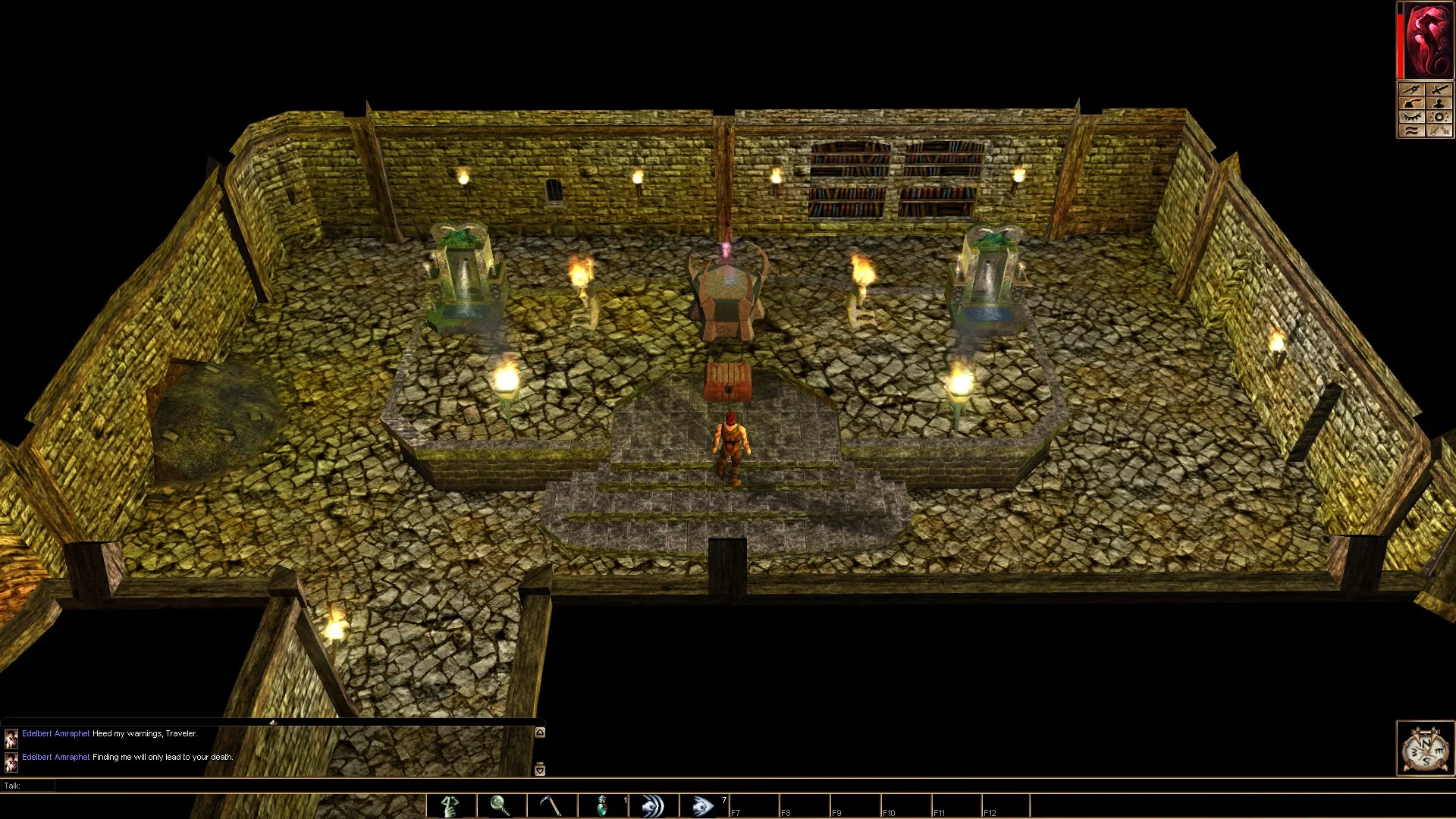Vesh Natu
Game: Neverwinter Nights: Enhanced Edition (Steam)
Engine: Aurora (NWN Toolset)
Development Cycle: 16 Weeks
Development Info
Summary
Vesh Natu was a story-driven project done for a Directed Focus Study (DFS) class within Neverwinter Nights while I was at the Guildhall. Keeping with the purpose of DFS classes to explore areas of passion, I decided to focus on creating a strong story and world within a gameworld setting. Vesh Natu’s story follows the story of an adventurer dealing with a conflict between a wizard and the ruling religious cult of the city of Vesh Natu.
Design Goals
Create a main quest with accompanying side quests that allow for a demonstration of progression
Create an engaging story that makes players care about the characters in the world
Create a zone that fits into the world setting of a larger existing world while both not contradicting and adding to the overall world lore
Glamour Shots
Download the module from this link
Keep scrolling for a breakdown of most of my areas
My Areas
*Note: All of the overhead screenshots were taken in-editor during a whitebox milestone. For my interior spaces, no layout changes were needed for layout after whitebox. Exterior spaces maintained the same layout from the sketches in the LDD, but did undergo continual size reductions as development progressed.
Vesh Natu Sewers
The sewers are the first spot where a player can experience combat in Vesh Natu. I utilized a simple, circular layout (as close as a square area based game can approcimate) to allow for player choice in terms of encounter experience. The bottom path features more combat opportunities (featuring goblins and other demi-human style enemies), but less loot options. Meanwhile, the upper path (going left in the picture from the “3” closest to the “1”), has fewer combat encounters (featuring more dwarf and human mercenaries), but they’re harder and there are more loot options. Both paths ultimately lead to the same goal location (the passage marked “4”).
Temple Sanctuary
This area was designed and implemented as more of a linear portion of the module. This is one of two dungeon zones that have any kind of story tied into the dungeon itself, the other being Edelbert’s lair (not pictured). This particular area does have a few areas to branch off from the critical path, but they are solely for world-building purposes or the advancement of sidequests (you can find dead guards in the area labeled 6, which advances a quest given by Regulus). The room labeled 7 features a fight with a much stronger minion of Edelbert, making it the first of three “boss battles” of the module. The room between rooms 7, 8, and 9 features a scripted event where the player encounters an astral projection of Edelbert, which helps further the plot and drops the first blatant hints that things within Vesh Natu might not be truly as it seems.
Abandoned Crypts
This area employs a similar philosophy to the sewers and mainly serves as a place for players to really experiment with how they’ve leveled up between the start of the module and the approach to the final set of battles. There is a body that can be looted in the bottom-left room that furthers another sidequest given by Regulus. The space accessed by passage “13” is Edelbert’s Lair, which is little more than a space to do battle with Edelbert.
Exterior and non-dungeon interior Areas
I designed the city of Vesh Natu to have three districts the player could go to, with one story-based interior area.
The Port District, where the player starts, does revolve around its market and the Drunken Kobold tavern, which players can go to supplies from a shop and information to help them piece together where to go for the main quest. This district also serves as the access hub for most of module, as Regulus, the city guard and giver of sidequests, idles in the area and all other districts and the sewers can be accessed here.
The Temple District, which is the second district needed, is home to both the Temple of Bedelmyre, but also my most intense scripted scene, in which Edelbert commits a murder. In comparison to the other districts, this district was supposed to be the picturesque garden and fountains that lead others to the temple. While the Temple of Bedelmyre and its archives are accessed through this district, it is the only district that doesn’t have a dungeon attributed to it.
The last district, the Beggar’s District, is more of a ruinous space than the others. Thematically, it’s both the grounds of an abandoned temple with its crypts and the most destitute district, subject to the poverty-stricken commoners and vagrants. Edelbert’s house is easily accessed from this cell, but primarily serves as a potential plot advancement space with an ambush combat encounter.
Postmortem
What Went Well
Over-documentation made implementation smooth
Accomplished goal of setting up a fleshed out world
First successful project with this engine produced a smooth product
What Went Wrong
Major technical problems
An update to a program on my main computer made the editor not responsive on my primary computer, forcing me to work on multiple computers.
Put off a simple, but tedious task until close to the end, which led to some inefficiencies with the project.
General lack of playtesters due to being the only person in the work-group with Neverwinter Nights.
Experimented and took risks with the engine too late to utilize creative solutions to problems to the maximum potential.
What I learned and am taking forward
Predicting and accounting for unknowns (difficulties) with thorough documentation allows for an easier time adjusting for any unknowns (including ones not predicted)
Experimenting should be done during the planning phase instead of just the problem-solving phase.








